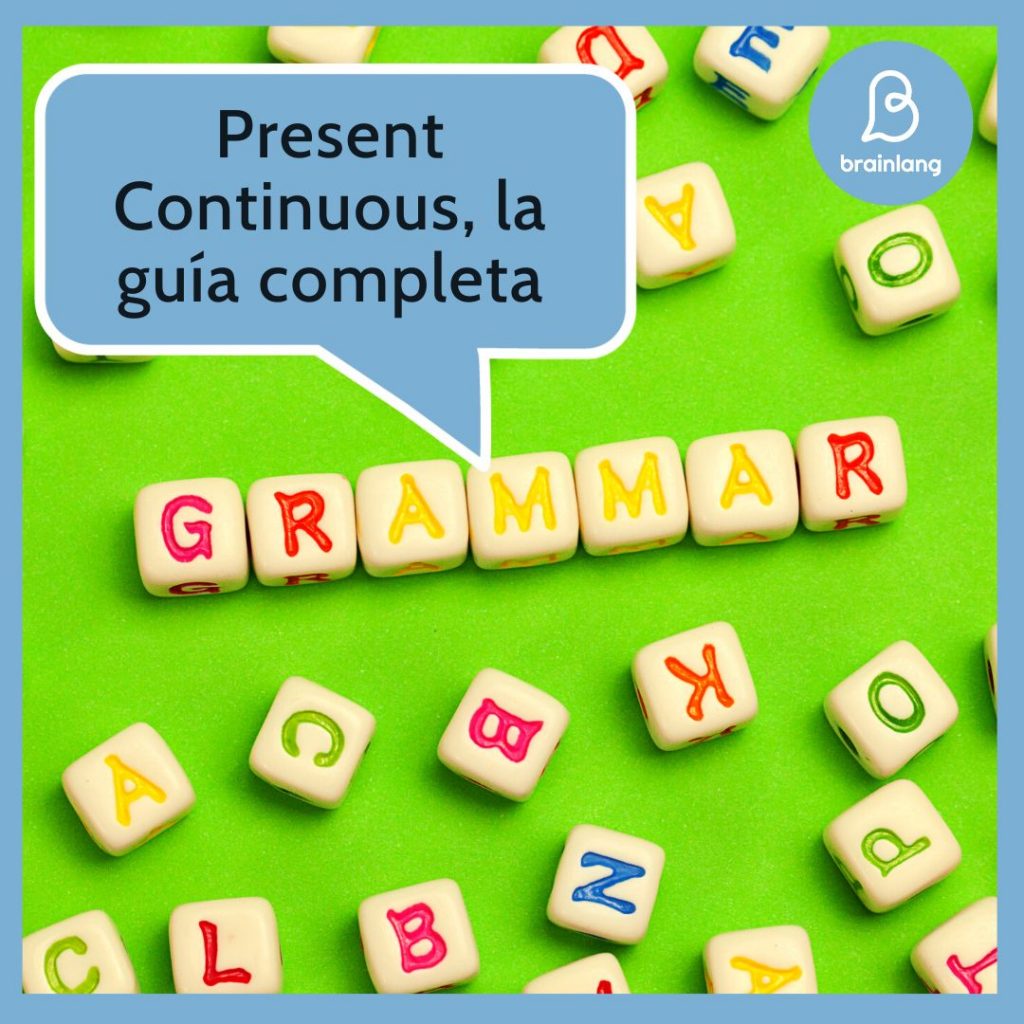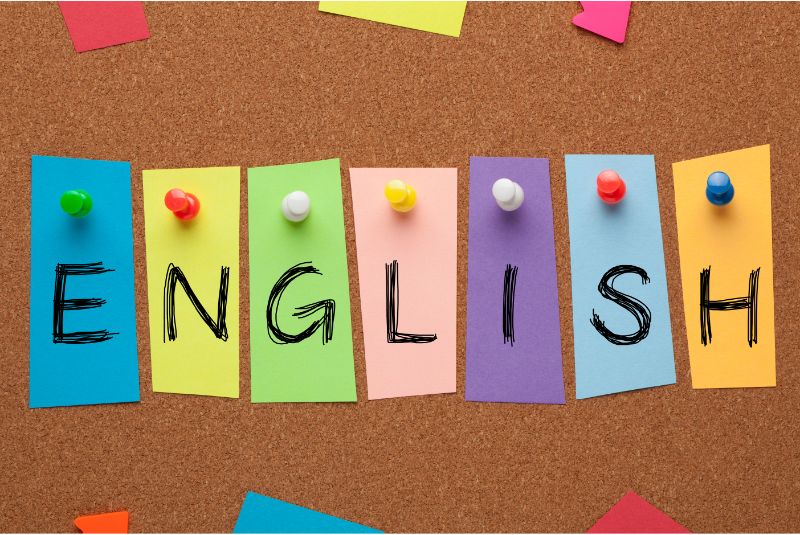
El Present Continuous en inglés es un tiempo verbal indispensable para tener fluidez y expresión en toda conversación.
En este artículo te vamos a contar todo sobre el presente continuo en inglés. Te traemos la guía definitiva con estructura, ejemplos, formación, usos, diferencias… ¡Resolvamos esas dudas! 😀
Present Continuous
El presente continuo o presente progresivo (Present Progressive) generalmente se refiere a situaciones o acciones que se están realizando en el momento. El presente continuo tiene la característica de agregar un sufijo ing hacia el final de cada verbo. Es algo similar a lo que en español llamamos gerundio, aplicando las terminaciones “-ando” o “-endo” (Estoy corriendo, estás andando, él está trabajando)
¿Cómo se forma el Present Continuous?
Para formar el presente continuo se utiliza el verbo auxiliar to be y el verbo+ing.
| Sujeto | Auxiliar (to be) | Verbo+ing |
| I | am | talking, eating, learning, doing, going… |
| he, she, it | is | talking, eating, learning, doing, going… |
| you, we, they | are | talking , eating, learning, doing, going… |
Reglas de ortografía del Presente Continuo
Al conjugar el present continuous, debes tener en cuenta las siguientes reglas.
- Cuando un verbo tiene una sola sílaba o cuyo acento recae en la última sílaba y finalizan en consonante, esta última deberá ser duplicada y se adicionará el -ing.
Ejemplos
I am running every morning (Estoy corriendo todas las mañanas)
We are not cutting the budget (No estamos cortando el presupuesto)
Are you playing with them? (¿Estás jugando con ellos?)
- Para los verbos finalizados en una -e que no se pronuncia, ésta debe ser reemplazada con el -ing.
Ejemplos:
He is dating a friend of my sister (Él está saliendo con una amiga de mi hermana)
You are not taking it seriously (No estás tomando esto en serio)
Is he riding a horse? (¿Él está montando a caballo?)
- Cuando el verbo termina con -ee, solo debe agregarse el -ing.
Ejemplos:
I am seeing you behind the curtains (Te estoy viendo detrás de las cortinas)
He is not fleeing from jail (Él no está huyendo de la cárcel)
Is your dog peeing my suitcase? (¿Está tu perro orinando en mi equipaje
- Cuando un verbo finaliza en -ie, estas letras deben reemplazarse con la -y y agregarse el -ing.
Ejemplos:
She is lying about what happened (Ella está mintiendo sobre lo que sucedió)
He is not dying of love (Él no está muriendo de amor)
Are we tying it well? (¿Lo estamos atando bien?)

Present Continuous– Estructura y conjugación
Afirmativa=Sujeto + verbo auxiliar (to be) + verbo+ing.
Negativa- Sujeto + verbo auxiliar (to be) + auxiliar negativo (not) + verbo +ing.
Interrogativa – Verbo auxiliar (to be) + sujeto + verbo+ing?
| Estructura y conjugación del Present Continuous(Verbo-Sing) | ||
| Afirmativa | Negativa | Interrogativa |
| I am singing in the rain | I am not singing in the rain | Am I singing in the rain? |
| You are singing in the rain | You are not singing in the rain | Are you singing in the rain? |
| He is singing in the rain | He is not singing in the rain | Is he singing in the rain? |
| It is singing in the rain | It is not singing in the rain | Is it singing in the rain? |
| We are singing in the rain | We are not singing in the rain | Are we singing in the rain? |
| They are singing in the rain | They are not singing in the rain | Are they singing in the rain? |
¿Para qué se usa el Present Continuous? Usos y Funciones
Como ocurre con todos los tiempos verbales del inglés, la actitud del hablante es tan importante como el momento en que ocurre la acción o el evento. Al emplear el present continuous, nos estamos refiriendo a algo que no ha terminado o está incompleto
Se utiliza para:
- Para hablar sobre algo que está pasando en el momento en el que hablamos. En muchas ocasiones la oración incluye palabras como now, at the moment, right now, etc.
Ejemplos:
I’m reading now Estoy leyendo ahora.)
She is cooking dinner at the moment (En este momento ella está haciendo la cena)
Is it raining? ¿Está lloviendo?)
Right now he’s talking, but yesterday he was unconscious (Ahora está hablando pero ayer él estaba inconsciente)
- Para describir una situación o evento temporales. Lo usamos para hablar de una tendencia o acción que está sucediendo en la actualidad pero no necesariamente cuando hablamos. En este caso, se utilizan expresiones de tiempo como currently, lately o these days.
Ejemplos:
He usually plays the drums, but he’s playing bass guitar tonight (Él normalmente toca la batería, pero esta noche está tocando la guitarra)
The weather forecast was good, but it’s raining at the moment (El pronóstico del tiempo era bueno, pero está lloviendo ahora mismo)
They’re learning English with BrainLang. (Están aprendiendo inglés con BrainLang.)
She is working a lot lately (Ella ha trabajado mucho últimamente)
More and more people are becoming vegetarian (Cada vez más gente se está volviendo vegetariana)
- Para describir una acción o evento futuros que ya están programados. Su uso indica que es bastante seguro que lo planificado o decidido sucederá en un futuro próximo.
Ejemplos:
I’m going to the cinema tonight. Voy al cine esta noche.)
He isn’t coming to class next week (No viene a la clase la semana que viene.)
Are you working tomorrow ? (¿Trabajas mañana?)
He is leaving in two hours. (Él se marcha en dos horas)
- Para describir y enfatizar una sucesión de acciones repetidas o describir características negativas de una persona. Se suele usar en este contexto always, forever, constantly,
Ejemplos:
He is always running at 6 am (Él siempre está corriendo a las 6 am)
Why are you always making me angry? (¿Por qué siempre me haces enfadar?)
Harry and Voldemort are always arguing! (Harry y Voldemort y están siempre discutiendo)
You’re constantly complaining about your mother-in-law! (¡Te estás quejando constantemente de tu suegra!)

Verbos en Presente Continuo en ingles
Hay verbos que no se suelen usar en los tiempos continuos. Te contamos los más comunes.
- be (ser/estar)
- want (querer)
- need (necesitar)
- know (saber/conocer)
- prefer (preferir)
- remember (recordar)
- understand (comprender)
- care (cuidar)
- see (ver)
- hear (oír)
- smell (oler)
- believe (creer)
- belong (pertenecer)
- cost (costar)
- seem (parecer)
- exist (existir)
- own (poseer)
- like (gustar)
- dislike (desagradar)
- love (amar)
- hate (odiar)
- fear (temer)
- envy (envidiar)
- mind (importar)
Si quieres saber más sobre estos verbos, consulta nuestro post sobre los stative verbs o verbos estáticos.
¿Cuál es la diferencia entre Present Simple y Present Continuous?
Si quieres saber con más detalle lee nuestro post sobre la diferencia en Present Simple y Present Continuous.



